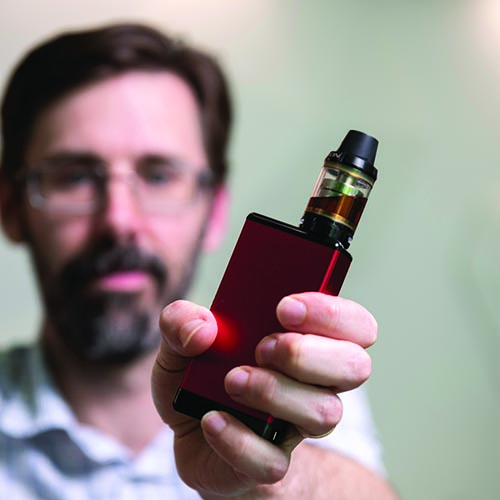Search

Research into the potential health impacts of vaping is starting to back up concerns that electronic cigarettes (e-cigarettes) are not as benign as many people think.
Research
Vitamin D deficiency at 16 to 20 weeks' gestation is associated with impaired lung function and asthma at 6 years of ageThis paper examines whether a Vitamin D deficiency during pregnancy affects the child's lung function predisposition towards lung disease such as asthma.
Research
The Global Lung Initiative 2012 reference values reflect contemporary Australasian spirometryWe aimed to ascertain the fit of the European Respiratory Society Global Lung Initiative 2012 reference ranges to contemporary Australasian spirometric data.
Research
Lung inflammation and simulated airway resistance in infants with cystic fibrosisCystic fibrosis (CF) is characterized by small airway disease; but central airways may also be affected. We hypothesized that airway resistance estimated from computational fluid dynamic (CFD) methodology in infants with CF was higher than controls and that early airway inflammation in infants with CF is associated with airway resistance.
Research
Parent Carer Quality of Life and Night-Time Attendance in Non-Ambulant Youth with Neuromuscular DisordersTo describe and explore carer quality of life and night-time attendance to their child in parents of non-ambulant youth with Neuromuscular Disorders. A cross-sectional population-based, comprehensive survey including the Adult Carer questionnaire, measures of social context and youths' physical status. Associations between carer-QoL or frequency of parents' night-time attendance with independent variables were explored using linear and logistic regression models, respectively.
Research
A brief history of MECP2 duplication syndrome: 20-years of clinical understandingMECP2 duplication syndrome (MDS) is a rare, X-linked, neurodevelopmental disorder caused by a duplication of the methyl-CpG-binding protein 2 (MECP2) gene-a gene in which loss-of-function mutations lead to Rett syndrome (RTT). MDS has an estimated live birth prevalence in males of 1/150,000.
Research
Addressing Race in Pulmonary Function Testing by Aligning Intent and Evidence With Practice and PerceptionThe practice of using race or ethnicity in medicine to explain differences between individuals is being called into question because it may contribute to biased medical care and research that perpetuates health disparities and structural racism.
Research
Early life predictors of obstructive sleep apnoea in young adults: Insights from a longitudinal community cohort (Raine study)Obstructive sleep apnea (OSA) increases the risk of perioperative adverse events in children. While polysomnography (PSG) remains the reference standard for OSA diagnosis, oximetry is a valuable screening tool. The traditional practice is the manual analysis of desaturation clusters derived from a tabletop device using the McGill oximetry score. However, automated analysis of wearable oximetry data can be an alternative. This study investigated the accuracy of wrist-worn oximetry with automated analysis as a preoperative OSA screening tool.
Research
Increasing airway obstruction through life following bronchopulmonary dysplasia: a meta-analysisFew studies exist investigating lung function trajectories of those born preterm; however growing evidence suggests some individuals experience increasing airway obstruction throughout life. Here we use the studies identified in a recent systematic review to provide the first meta-analysis investigating the impact of preterm birth on airway obstruction measured by the forced expiratory volume in 1 s (FEV1) to forced vital capacity (FVC) ratio.
Research
Normal values of respiratory oscillometry in South African children and adolescentsNoninvasive measurement of respiratory impedance by oscillometry can be used in young children aged from 3 years and those unable to perform forced respiratory manoeuvres. It can discriminate between healthy children and those with respiratory disease. However, its clinical application is limited by the lack of reference data for African paediatric populations. The aim of the present study was to develop reference equations for oscillometry outcomes in South African children and adolescents.
